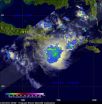(Press-News.org) Although genome-wide association studies have linked DNA variants in the gene SCN10A with increased risk for cardiac arrhythmia, efforts to determine the gene's direct influence on the heart's electrical activity have been unproductive. Now, scientists from the University of Chicago have discovered that these SCN10A variants regulate the function of a different gene, SCN5A, which appears to be the primary gene responsible for cardiac arrhythmia risk. The SCN10A gene itself plays only a minimal role in the heart, according to the study, published in the Journal of Clinical Investigation on March 18.
"Significant effort has been invested into understanding the function of SCN10A in cardiac rhythm control, with underwhelming results," said study co-leader Ivan Moskowitz MD, PhD, associate professor of pediatrics, pathology and human genetics at the University of Chicago. "It turns out that the genetic variation within SCN10A that confers arrhythmia risk actually functions on a different gene. This study highlights the fact that DNA variation associated with disease can have regulatory impact on functional targets located a considerable distance away."
Mutations within the SCN10A gene are linked with increased risk of Brugada Syndrome, which causes cardiac arrhythmias and is a leading cause of death amongst youth in some parts of the world. Genome-wide association studies—large scale experiments that look for genetic variants across the human genome with statistical associations to certain traits or diseases—were used to identify these variants, but follow-up studies have been unable to determine their function.
Curious about previous ambiguous results, Moskowitz and his colleagues looked for other genes with links to SCN10A. First, they discovered that the region of SCN10A that conferred arrhythmia risk physically contacted a neighboring gene—SCN5A—which is well-known to have an important role in cardiac arrhythmias and sudden cardiac death. They then showed that these contacts are functional, and that by removing the implicated sequences from SCN10A, expression of SCN5A was profoundly diminished.
When they analyzed large-scale human data, the team found that the SCN10A variant originally identified for Brugada Syndrome risk was associated with lowered levels of SCN5A. But the variant had no detectable effect on the levels of SCN10A.
Taken together, the evidence suggests that any link between SCN10A and cardiac arrhythmia is due to its connection with SCN5A expression. Through the results of this study, Moskowitz believes scientists will now focus on the correct gene, SCN5A, to better understand genetic risk for cardiac arrhythmia and hopes this will lead to more accurate diagnostics and potential therapies in the future.
This study also illustrates how highly-publicized genome-wide association studies can be misleading for researchers. Study co-leader Marcelo Nobrega, PhD, an associate professor of human genetics at the University of Chicago, published a similar finding for a gene associated with obesity, on March 12th in Nature.
"Genome-wide association studies have been very successful in implicating genetic variation associated with a host of human diseases and traits," Moskowitz said. "However cases like this study demonstrate that we must be more careful to evaluate the functional target of genome-wide association study hits, before we jump to conclusions that can have costly implications for how we investigate human health and generate disease diagnostics and therapies."
INFORMATION:
The study, "A common genetic variant within SCN10A modulates cardiac SCN5A expression," was funded by the National Institutes of Health, the European Community's Seventh Framework Programme contract, the Cardiovascular Onderzoek Nederland, the German Foundation for Heart Research and the Federal Ministry of Education and Research. Additional authors include Malou van den Boogaard, Scott Smemo, Ozanna Burnicka-Turek, David E. Arnolds, Harmen J.G. van de Werken, Petra Klous, David McKean, Jochen D. Muehlschlegel, Julia Moosmann, Okan Toka, Xinan H. Yang, Tamara T. Koopmann, Michiel E. Adriaens, Connie R. Bezzina, Wouter de Laat, Christine Seidman, J.G. Seidman, Vincent M. Christoffels and Phil Barnett.
Genome-wide association studies mislead on cardiac arrhythmia risk gene
2014-03-20
ELSE PRESS RELEASES FROM THIS DATE:
Oregon physicists use geometry to understand 'jamming' process
2014-03-20
EUGENE, Ore. -- (March 20, 2014) -- University of Oregon physicists using a supercomputer and mathematically rich formulas have captured fundamental insights about what happens when objects moving freely jam to a standstill.
Their approach captures jamming -- the point at which objects come together too tightly to move -- by identifying geometric signatures. The payoff, while likely far down the road, could be a roadmap to preventing overfilled conveyor belts from stopping in factories, separating oil deposits trapped in sand, or allowing for the rapid, efficient transfer ...
Mayo Clinic researchers find genetic clue to irritable bowel syndrome
2014-03-20
ROCHESTER, Minn. — March 20, 2014 — Is irritable bowel syndrome (IBS) caused by genetics, diet, past trauma, anxiety? All are thought to play a role, but now, for the first time, researchers have reported a defined genetic defect that causes a subset of IBS. The research was published in the journal Gastroenterology.
Researchers estimate that approximately 15 to 20 percent of the Western world has IBS. It is a common disorder that affects the large intestine. Most patients with the disorder commonly experience symptoms of cramping, abdominal pain, bloating gas, diarrhea ...
Health insurance coverage increased ER use in Massachusetts
2014-03-20
WASHINGTON — The implementation of health care reform in Massachusetts – principally the expansion of health insurance coverage to nearly everyone in the state – was associated with a small but consistent increase in emergency department use, according to the findings of a study to be published online today in Annals of Emergency Medicine ("Increased Use of the Emergency Department After Health Care Reform in Massachusetts").
"This obviously has implications about what we can expect to see nationally as the roll-out of the Affordable Care Act continues," said Peter ...
Big government -- or good neighbors -- can improve people's health
2014-03-20
Lincoln, Neb., March 20, 2014 – The nation's left-leaning citizens might be pleased by the findings of a new University of Nebraska study that finds those who live in liberal states tend to be healthier.
But conservatives could also take satisfaction in the same study's conclusion that strong communities also foster better health.
"Some people might like the argument that liberal government automatically leads to healthier people, because it supports their worldview," said Mitchel Herian, a faculty fellow with the university's Public Policy Center and lead researcher ...
Plankton make scents for seabirds and a cooler planet
2014-03-20
The top predators of the Southern Ocean, far-ranging seabirds, are tied both to the health of the ocean ecosystem and to global climate regulation through a mutual relationship with phytoplankton, according to newly published work from the University of California, Davis.
When phytoplankton are eaten by grazing crustaceans called krill, they release a chemical signal that calls in krill-eating birds. At the same time, this chemical signal — dimethyl sulfide, or DMS — forms sulfur compounds in the atmosphere that promote cloud formation and help cool the planet. Seabirds ...
Wind farms can provide society a surplus of reliable clean energy, Stanford study finds
2014-03-20
The worldwide demand for solar and wind power continues to skyrocket. Since 2009, global solar photovoltaic installations have increased about 40 percent a year on average, and the installed capacity of wind turbines has doubled.
The dramatic growth of the wind and solar industries has led utilities to begin testing large-scale technologies capable of storing surplus clean electricity and delivering it on demand when sunlight and wind are in short supply.
Now a team of Stanford researchers has looked at the "energetic cost" of manufacturing batteries and other storage ...
Satellite confirms Tropical Cyclone Mike's quick disappearing act
2014-03-20
Tropical Cyclone Mike didn't even last a day in the Southern Pacific Ocean as NOAA's GOES-West satellite revealed the storm dissipating just 24 hours after it was born.
The Joint Typhoon Warning Center's second update on Tropical Cyclone Mike was its last. At 2100 UTC/5 p.m. EDT Mike was located near 24.3 south latitude and 157.9 west, about 618 nautical miles/711.1 miles/ 1,145 km southwest of Papeete, Tahiti. Maximum sustained winds were near 35 knots/40 mph/62 kph at that time.
All warnings for the Southern Cook Islands were cancelled and Mike was quickly weakening ...
Face it: Instagram pictures with faces are more popular
2014-03-20
Like them or not, there's more proof that selfies aren't going away any time soon. Georgia Institute of Technology and Yahoo Labs researchers looked at 1.1 million photos on Instagram and found that pictures with human faces are 38 percent more likely to receive likes than photos with no faces. They're also 32 percent more likely to attract comments. The study is one of the first to examine how photos with faces drive engagement on large-scale, image-sharing communities.
The researchers also found that the number of faces in the photo, their age or gender didn't make ...
NASA sees ex-Tropical Cyclone Gillian's remnants persist
2014-03-20
NASA's TRMM satellite continues to follow the remnants of former Tropical Cyclone Gillian as it moved from the Southern Pacific Ocean into the Southern Indian Ocean where it appears to be re-organizing.
The persistent remnants of tropical cyclone Gillian have moved westward over 2,700 km/1,674 miles since forming in the Gulf of Carpentaria on March 8, 2014.
Gillian's coherent remnants were located just to the southeast of the Indonesian island of Java when the Tropical Rainfall Measuring Mission or TRMM satellite flew overhead on March 20, 2014 at 0415 UTC/12:15 a.m. ...
Interpreting neuroimages: The technology and its limits
2014-03-20
Neuroimages play a growing role in biomedical research, medicine, and courtrooms, as well as in shaping our understanding of what it means to be human. But how helpful are they at answering complex questions such as: What is depression? Is a defendant lying? Do we have free will?
These are among the topics explored in Interpreting Neuroimages: An Introduction to the Technology and Its Limits, a special report of the Hastings Center Report. It is edited by Josephine Johnston, a research scholar and director of research, and Erik Parens, a senior research scholar, and ...





